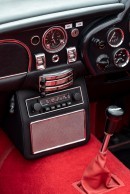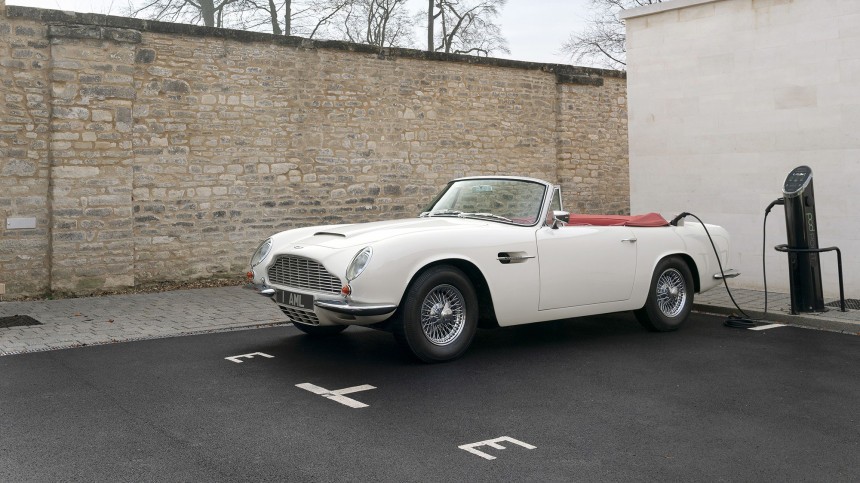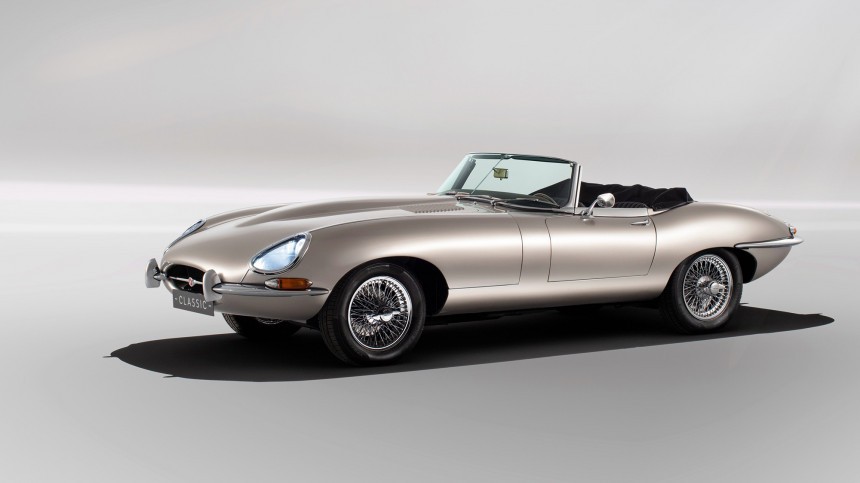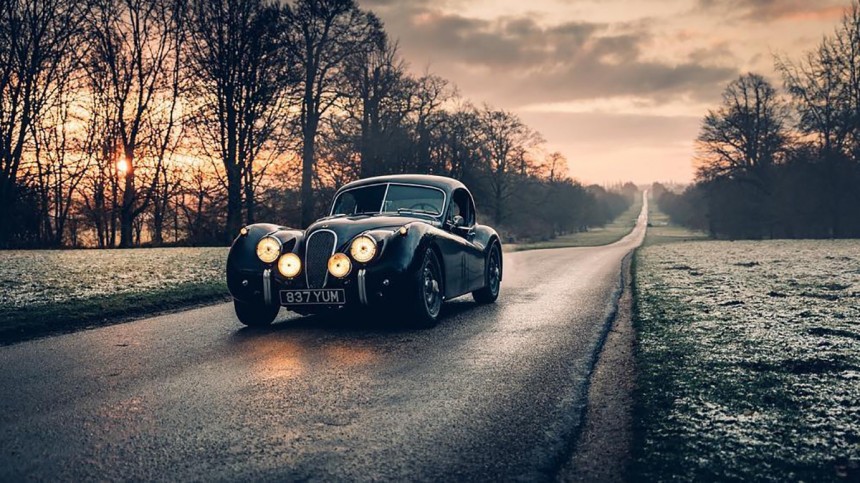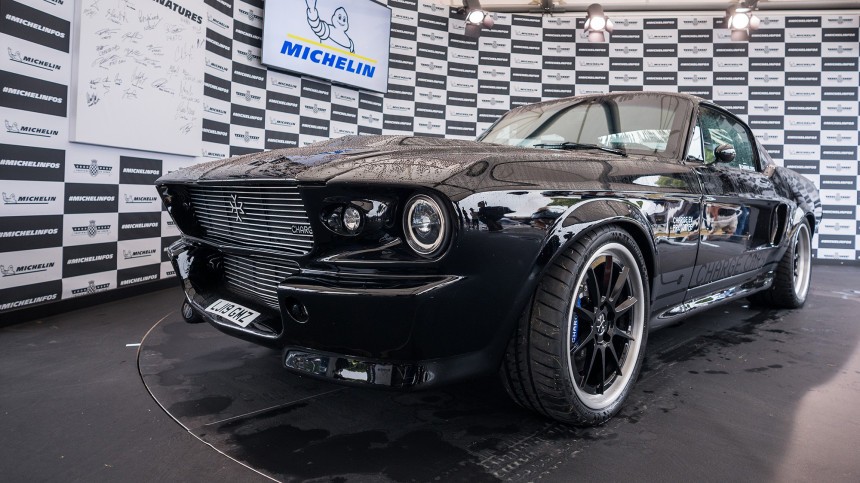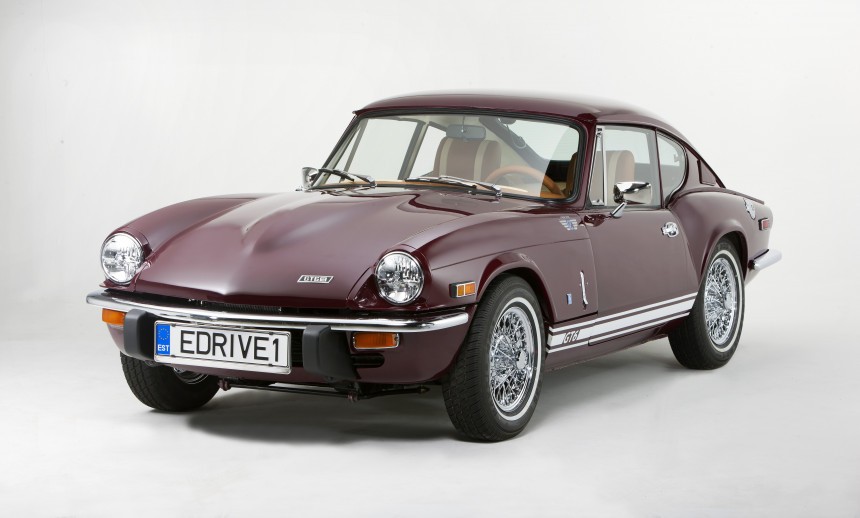Classic cars’ value is higher the closer they are to the state in which they originally left the factory. If they are modified (even if this means genuine, usable upgrades), their value will usually go down since originality is prized above all else.
But old cars are often slow and noisy by today’s standards (even most of the ones that used to be quite quick back in the day) and while enthusiasts will certainly get a kick out of reliving the experience people had when the car was new, the fact is most do show their age (in a bad way). Classics are nowhere near as safe, comfortable, clean or refined as modern cars, although there is one way in which they can be improved, even if this means losing the highly sought after originality.
And that's ripping out their smoky old internal combustion engine and replacing it with an electric motor and batteries. Sure, some purists’ faces may change to resemble Norwegian expressionist painter Edvard Munch’s The Scream upon hearing this, since they couldn’t conceive driving, say, a Jaguar E-Type without the glorious thrum of its straight-six in the background. But it might not be such a bad idea after all.
Hear me out. Limitations on where cars with highly polluting engines will legally be allowed to go will constantly increase in coming years (especially in Europe). Cities are cracking down on the internal combustion-engine car and old cars are the ones that pollute the most. So, in the not too distant future, you won’t really be able to drive your original classic as freely as you can now - you have been warned.
For people who aren’t self declared purists, yet they still love the look and feel of classic cars, an all-electric powertrain in an old car won’t make it worse - it will make it better. As I’m writing this, I’m not exactly sure where I stand on this type of conversion, since I think it’s more suited to some cars rather than others - you have less remorse when converting a car that was very common versus one that’s quite rare and unique (i.e. making an old VW Beetle electric is by no means the same as making, say, a rare 1960s Ferrari or Aston Martin).
One thing is certain, though - an EV converted classic will be considerably more reliable since its power plant has far fewer moving parts. Classic car engines are known to be prone to failing, while electric motors don’t really fail all that often.
Even if opinions on the matter are split, companies have speculated that there is some demand for classic cars with electric powertrains, and if you’re now in the market for such a car, you have a very wide range of options to choose from. Their prices vary from sums that make you say “OK, I’ll take out a small loan for that” to ones that make you say “but I only have one liver to sell.” Do note that the vehicles mentioned below are more from the latter category...
The first EV-converted classic is from the “I need to sell three or four human livers to afford it,” range: the Aston Martin DB6 Volante Electric, made by Aston Martin Works. With the exorbitant price that a DB6 can fetch these days and the additional €230,000 ($255,000) of the proof of concept vehicle (currently the only one made) is worth around €1.5-million ($1.66-million).
This electrified classic is therefore clearly aimed at collectors who already have many other cars in their garage, but that doesn’t make it any less exquisite (quite the contrary, actually). It’s in fact Aston Martin’s first pure-EV, the automaker doesn’t just want to electrify the DB6. In fact, it’s setting up a program where you’ll be able to bring in you DB4, DB5, DB6 or DBS and for the aforementioned cost it will undergo a (fully-reversible) conversion to electricity.
In terms of performance, Aston has only said that the new electric powertrain will provide similar performance to the internal combustion engine that’s being removed, as well as the same weight in order for the car not to need different brakes or suspension. Aston plans to start offering the conversion in 2020.
Some say Aston Martin decided to set up its classic EV conversion program after Jaguar announced it would start selling an all-electric version of its iconic E-Type two-door. Called the E-Type Zero, it is expected to cost around €345,000 ($384,600) and Jaguar says its electric powertrain will provide similar performance to the car’s original 3.8-liter straight-six. You can already pre-order one with deliveries slated to commence sometime in 2020.
There’s another electrified E-Type on the market (available in early 2020), from an Irish firm called Electrifi which specializes in EV conversions and it made a €40-million ($44-million) deal with another company, U.K.-based E-Type restoration specialists Evolution, to supply them with restored E-Types for them to convert.
Just like the factory EV E-Type conversion (and the Aston Martin EV conversion) deal, the electrification is fully reversible, but unlike in Aston’s case, these electric E-Types will be given uprated brakes and suspension in order to cope with the extra weight and power (the E-Type by Electrifi will have 450 horsepower). If you thought the official Jaguar version was expensive, then this second one is definitely not for you as it costs from €850,000 ($938,000).
While many say the E-Type is the best looking Jaguar ever made, or even the best looking car ever made, I’m probably in the minority in my view that the earlier XK120 is even sexier. That’s why I was really excited to discover there’s a company that called Lunaz which makes a great EV conversion/restomod out of it, although its €405,000 ($450,000) sticker gave me a quick and brutal reality check.
The Silverstone-based company rips out the XK’s six-cylinder and replaces it with two electric motors that draw juice from a big 80 kWh battery pack split into two parts - one located under the hood, in place of the original power plant, while the other is in the rear, where the gas tank used to be.
The two electric motors make a combined 375 horsepower and in order to keep everything in check, the suspension has been stiffened and the brakes have been upgraded. Actual performance numbers have not been made public, though, but you can bet it’s going to strain your neck muscles under hard acceleration.
Lunaz also makes an all-electric version of the Rolls Royce Cloud which can be equipped with a really big battery pack of up to 120 kWh. The range it bestows the 1960s isn’t disclosed, nor are its performance numbers, but with the instant shove provided by electric motors, it will most likely be quite a bit faster than the original.
What is known about it right now is that it will cost about the same as the XK120, from €405,000 ($450,000). Both this Rolls and the Jag will feature regenerative braking, fast charging capability, as well as more comfort-oriented amenities like traction control, cruise control and sat-nav.
Unlike pretty much every other car on this list, it must be said that making a Rolls Royce quieter seems quite fitting. You really don't want to hear any kind of powertrain noise in a Rolls, so this particular conversion seems spot on.
Ford’s Mustang is about as iconic as classic cars get and should you want its gorgeous 1960s lines mixed with a thoroughly modern all-electric powertrain, then U.K.-based Charge Cars has the vehicle for you. The car’s shell is an original late ‘60s Mustang fastback, powered by a pair of electric motors with a combined 469 horsepower and a whopping 1,200 Nm (885 pound-feet) of torque.
That’s enough to send the Charge Mustang to sixty in four seconds and on to a top speed of 240 km/h (149 mph). The car’s top speed is certainly considerably higher than that of many new EVs from established manufacturers.
The company that makes it says the 64 kWh battery pack is good for a range of 320 km (200 miles) and that it supports fast charging up to 50 kW. They plan to make 499 examples with prices starting at €337,360 ($373,600), but this can be increased if you add options.
Here’s another British classic whose internal-combustion engine has been thrown out and replaced with an electric motor. The E-GT6 Coupe, based on the 1960s Triumph GT6, is a high quality EV conversion that promises improved reliability (a sore spot of old Triumphs), more performance and at least just as much driving fun as the original.
Its electric motor only makes 145 horsepower, but that’s 50 more horsepower than the original 2.0-liter engine could muster, plus it has a lot more (instant) torque - 290 Nm (215 pound-feet). Power is drawn from a 19 kWh battery pack that provides the vehicle with a range of 125 km (77 miles).
Pricing is available upon request, but judging by the level of workmanship the car has, it definitely isn’t cheap. It will cost at least €150,000, according to some reports.
And that's ripping out their smoky old internal combustion engine and replacing it with an electric motor and batteries. Sure, some purists’ faces may change to resemble Norwegian expressionist painter Edvard Munch’s The Scream upon hearing this, since they couldn’t conceive driving, say, a Jaguar E-Type without the glorious thrum of its straight-six in the background. But it might not be such a bad idea after all.
Hear me out. Limitations on where cars with highly polluting engines will legally be allowed to go will constantly increase in coming years (especially in Europe). Cities are cracking down on the internal combustion-engine car and old cars are the ones that pollute the most. So, in the not too distant future, you won’t really be able to drive your original classic as freely as you can now - you have been warned.
For people who aren’t self declared purists, yet they still love the look and feel of classic cars, an all-electric powertrain in an old car won’t make it worse - it will make it better. As I’m writing this, I’m not exactly sure where I stand on this type of conversion, since I think it’s more suited to some cars rather than others - you have less remorse when converting a car that was very common versus one that’s quite rare and unique (i.e. making an old VW Beetle electric is by no means the same as making, say, a rare 1960s Ferrari or Aston Martin).
One thing is certain, though - an EV converted classic will be considerably more reliable since its power plant has far fewer moving parts. Classic car engines are known to be prone to failing, while electric motors don’t really fail all that often.
Even if opinions on the matter are split, companies have speculated that there is some demand for classic cars with electric powertrains, and if you’re now in the market for such a car, you have a very wide range of options to choose from. Their prices vary from sums that make you say “OK, I’ll take out a small loan for that” to ones that make you say “but I only have one liver to sell.” Do note that the vehicles mentioned below are more from the latter category...
Aston Martin DB6 electric
This electrified classic is therefore clearly aimed at collectors who already have many other cars in their garage, but that doesn’t make it any less exquisite (quite the contrary, actually). It’s in fact Aston Martin’s first pure-EV, the automaker doesn’t just want to electrify the DB6. In fact, it’s setting up a program where you’ll be able to bring in you DB4, DB5, DB6 or DBS and for the aforementioned cost it will undergo a (fully-reversible) conversion to electricity.
In terms of performance, Aston has only said that the new electric powertrain will provide similar performance to the internal combustion engine that’s being removed, as well as the same weight in order for the car not to need different brakes or suspension. Aston plans to start offering the conversion in 2020.
Jaguar E-Type
There’s another electrified E-Type on the market (available in early 2020), from an Irish firm called Electrifi which specializes in EV conversions and it made a €40-million ($44-million) deal with another company, U.K.-based E-Type restoration specialists Evolution, to supply them with restored E-Types for them to convert.
Just like the factory EV E-Type conversion (and the Aston Martin EV conversion) deal, the electrification is fully reversible, but unlike in Aston’s case, these electric E-Types will be given uprated brakes and suspension in order to cope with the extra weight and power (the E-Type by Electrifi will have 450 horsepower). If you thought the official Jaguar version was expensive, then this second one is definitely not for you as it costs from €850,000 ($938,000).
Jaguar XK120
The Silverstone-based company rips out the XK’s six-cylinder and replaces it with two electric motors that draw juice from a big 80 kWh battery pack split into two parts - one located under the hood, in place of the original power plant, while the other is in the rear, where the gas tank used to be.
The two electric motors make a combined 375 horsepower and in order to keep everything in check, the suspension has been stiffened and the brakes have been upgraded. Actual performance numbers have not been made public, though, but you can bet it’s going to strain your neck muscles under hard acceleration.
Rolls Royce Phantom V
What is known about it right now is that it will cost about the same as the XK120, from €405,000 ($450,000). Both this Rolls and the Jag will feature regenerative braking, fast charging capability, as well as more comfort-oriented amenities like traction control, cruise control and sat-nav.
Unlike pretty much every other car on this list, it must be said that making a Rolls Royce quieter seems quite fitting. You really don't want to hear any kind of powertrain noise in a Rolls, so this particular conversion seems spot on.
Ford Mustang
That’s enough to send the Charge Mustang to sixty in four seconds and on to a top speed of 240 km/h (149 mph). The car’s top speed is certainly considerably higher than that of many new EVs from established manufacturers.
The company that makes it says the 64 kWh battery pack is good for a range of 320 km (200 miles) and that it supports fast charging up to 50 kW. They plan to make 499 examples with prices starting at €337,360 ($373,600), but this can be increased if you add options.
Triumph GT6
Its electric motor only makes 145 horsepower, but that’s 50 more horsepower than the original 2.0-liter engine could muster, plus it has a lot more (instant) torque - 290 Nm (215 pound-feet). Power is drawn from a 19 kWh battery pack that provides the vehicle with a range of 125 km (77 miles).
Pricing is available upon request, but judging by the level of workmanship the car has, it definitely isn’t cheap. It will cost at least €150,000, according to some reports.
























